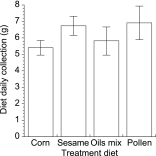Omega-3 deficiency impairs honey bee learning
- PMID: 26644556
- PMCID: PMC4697434
- DOI: 10.1073/pnas.1517375112
Omega-3 deficiency impairs honey bee learning
Erratum in
-
Correction for Arien et al., Omega-3 deficiency impairs honey bee learning.Proc Natl Acad Sci U S A. 2021 Aug 31;118(35):e2112851118. doi: 10.1073/pnas.2112851118. Proc Natl Acad Sci U S A. 2021. PMID: 34400548 Free PMC article. No abstract available.
Abstract
Deficiency in essential omega-3 polyunsaturated fatty acids (PUFAs), particularly the long-chain form of docosahexaenoic acid (DHA), has been linked to health problems in mammals, including many mental disorders and reduced cognitive performance. Insects have very low long-chain PUFA concentrations, and the effect of omega-3 deficiency on cognition in insects has not been studied. We show a low omega-6:3 ratio of pollen collected by honey bee colonies in heterogenous landscapes and in many hand-collected pollens that we analyzed. We identified Eucalyptus as an important bee-forage plant particularly poor in omega-3 and high in the omega-6:3 ratio. We tested the effect of dietary omega-3 deficiency on olfactory and tactile associative learning of the economically highly valued honey bee. Bees fed either of two omega-3-poor diets, or Eucalyptus pollen, showed greatly reduced learning abilities in conditioned proboscis-extension assays compared with those fed omega-3-rich diets, or omega-3-rich pollen mixture. The effect on performance was not due to reduced sucrose sensitivity. Omega-3 deficiency also led to smaller hypopharyngeal glands. Bee brains contained high omega-3 concentrations, which were only slightly affected by diet, suggesting additional peripheral effects on learning. The shift from a low to high omega-6:3 ratio in the Western human diet is deemed a primary cause of many diseases and reduced mental health. A similar shift seems to be occurring in bee forage, possibly an important factor in colony declines. Our study shows the detrimental effect on cognitive performance of omega-3 deficiency in a nonmammal.
Keywords: Apis mellifera; alpha-linolenic acid; associative conditioning; fatty acids; proboscis extension response.
Conflict of interest statement
The authors declare no conflict of interest.
Figures





References
-
- Hulbert AJ, Abbott SK. Nutritional ecology of essential fatty acids: An evolutionary perspective. Aust J Zool. 2012;59(6):369.
-
- Watson RR, Meester FD, editors. Omega-3 Fatty Acids in Brain and Neurological Health. Elsevier; Amsterdam: 2014.
-
- Stanley-Samuelson DW, Pedibhotla VK. What can we learn from prostaglandins and related eicosanoids in insects? Insect Biochem Mol Biol. 1996;26(3):223–234. - PubMed
Publication types
MeSH terms
Substances
LinkOut - more resources
Full Text Sources
Other Literature Sources

